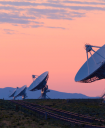Developing innovative, ground-breaking technology
When used in space, sensors are able to provide a huge number of possibilities, such as being able to map tiny changes in the strength of gravity across the Earth’s surface. The extreme sensitivity brought by the cold atom sensors will mean that the movements of mass with the earth systems can be finely monitored.
Combining industry and academic expertise, we are developing and building a quantum gravimeter which can measure the force of gravity more accurately than ever before. Once developed, we expect the gravimeter to be able to measure large-scale changes in our planet, which can feed into climate models and help researchers to predict, assess and monitor natural disasters such as flooding, earthquakes and volcanic activity.
Previous satellite gravity missions have given us low-resolution images, but quantum gravimeters will drive the spatial resolution down to tens of kilometers. This will hugely impact the way we
are able to manage water and will also help to reduce natural disasters. In terms of economic benefit, the UK will benefit from refining insurance risk models and mitigated flood impacts.
CASPA (Cold Atom Space Payload) is an Innovate UK project which partners with the University of Birmingham, the University of Southampton’s Optical Research Centre, Cohesion, XCAM, Clyde Space and Gooch & Housego.
The teams involved in the project hope to be able to implement this technology into a small satellite payload, which will be capable of producing ‘cold atoms’ in space, to test the core building blocks of a future cold atom instrument. Project CASPA should be ready for flight in 2020, soon after the project’s official end date. The project’s objective is to prove that it has built a viable platform for cold atoms technology in space, which will be the first time this has been achieved on a free-flying satellite.
Professor Trevor Cross, Chief Technology Officer, Teledyne e2v: “We’re building a small satellite which we call CASPA – Cold Atom Space Payload and this will demonstrate that core technology will be required in future missions to measure gravity from space and this will lead to tremendous new capabilities that could include monitoring the water tables around the globe on a consistent 24-hour basis and may even help with the identification of imminent earthquakes.”












